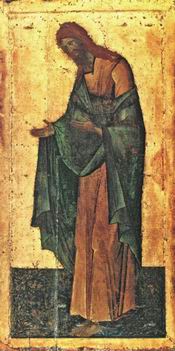

|
|
The System of Frescoes and Its General Idea
|
 |
|
|
Noteworthy for us are the representations of the righteous men (not the prophets) in the dome, extremely developed martyrs' cycle in the sections under the dome and an impressive gallery of the stylites, hermits and saints in the Trinity Chapel at the gallery. The pious life of all those saints is the unifying feature of the whole group. Theophanes probably wanted to emphasise the fact that only sinless and pure, God-fearing life results in salvation. He appealed to people to choose such form of existence, which would purify and bring closer to the God. And since the earthly life was considered to be temporary, just a transition to the eternal bliss in Heaven, or to the perpetual Hell torments, the meditations on the pious or sinful life were directly connected with the idea of the end of the world, when Christ would judge the living and the dead and do justice for the good and evil. Therefore all the frescoes in the Church of the Saviour are permeated with keen thought of the last days of the world. But the painter is concentrated not upon the Last Judgement as such, but preparation for it, i. e. the transient life of Man, his agonising struggle on his way between Good and Evil, meditation on how difficult and simultaneously indispensable is the deed he must fulfil, and that it is impossible to get happiness on Earth and eternal bliss in Heaven.
The Style of Wall Painting in the Church of the Saviour
Unlike large and small compositions characteristic of the fourteenth-century Greek, Bulgar, Serbian and Russian art the paintings by Theophanes in the Church of the Saviour were executed in massive forms, striking in their monumentality. The average height of the figures reaches two metres. Subject scenes became also noticeably enlarged. (Thus the Nativity of Christ fresco had five metres in height and four and a half metres in breadth.) Background plays not a small part in the whole ensemble and because of that compositions and individual personages are distributed loosely at some distance from each other. Being a part of entire system they may be viewed as independent representations.
Clearly perceptible alternation of figures and vast sections of unpainted and just coloured background makes the decorative scheme of the church harmoniously balanced and beautiful. It should be mentioned however that Theophanes did not follow this principle of composition everywhere. He combines large and small-scale pieces, individual personages and subject scenes, breaks the rule of strict frontal interpretation and encloses the frescoes in the rectangular or medallion frame. Sometimes though not often he uses ornamental motifs. Certain deviation from the system of tiers in the distribution of frescoes occurs. By all these means the rhythm of the paintings is infused with a new and varied cadence. Theophanes appears before the viewer as a brilliant master of composition.
The frescoes in the Church of the Saviour are distinguished by peculiar colour scheme. Students of the fourteenth-century art, accustomed to the polychromy or even motley painting, are struck by the almost monochromatic gamut of the frescoes. Reddish-brown, terracotta colour prevails. This colour was obtained from the local minerals and was thus widely used in Novgorod as well as in the neighbouring Pskov. But it would be wrong to speak of the monochromatic palette of the Theophanes works. Together with the reddish-brown he used yellow, white, blue, green, orange, black paints. But they often blend giving in result hardly distinguishable tints of pale grey, lilac, bluish and greenish-yellow. Pale, subdued paints are especially pronounced in the background, which lacked customary undercoat and thus was not painted blue or silvery blue. Dark figures seem to emerge out of the hazy silvery-blue background their darkness thus being intensified. Following the hitherto poorly studied current which was marked out by Professor K. Veitsman, Theophanes the Greek aimed at creating a large-scale ensemble of wall painting in the Church of the Saviour with economic but expressive means. He was successful in solving this difficult artistic task.
Theophanes was a painter born. Seldom did he employ grafya (in order to improve the effectiveness of the guide lines, these were grooved into the damp ground) and even preliminary sketch served as general outline for his brushwork. Frequently the painter deviated from the sketch. Therefore the final variant did not as a rule coincide with the preliminary outline. Theophanes' manner is free and bold, devoid of anything fixed or immovable. The painter does not go into details and stresses only the main features of the subject. This fact explains why he paid so little attention to the landscape and architectural background, while his contemporaries took great interest in them.
Theophanes favours contrasts. At the finishing stage he would deliberately thicken the dark colours and brighten the light ones. The transitional tints as they are disappear and contrasts are sharply intensified. His dark is dark in the extreme, bordering on gloomy, and his light aquires the dazzling quality of whiteness. But the dominating device is highlights characteristic of Theophanes solely. They are performed in a bold and decisive manner with pure white or white with a tint of blue. Energetic highlights are put arbitrarily, their direction changing. They are a powerful means to achieving the necessary emotional imphasis, a device to strengthen dramatic tension, which communicates to the viewer.
Continue »
|
|